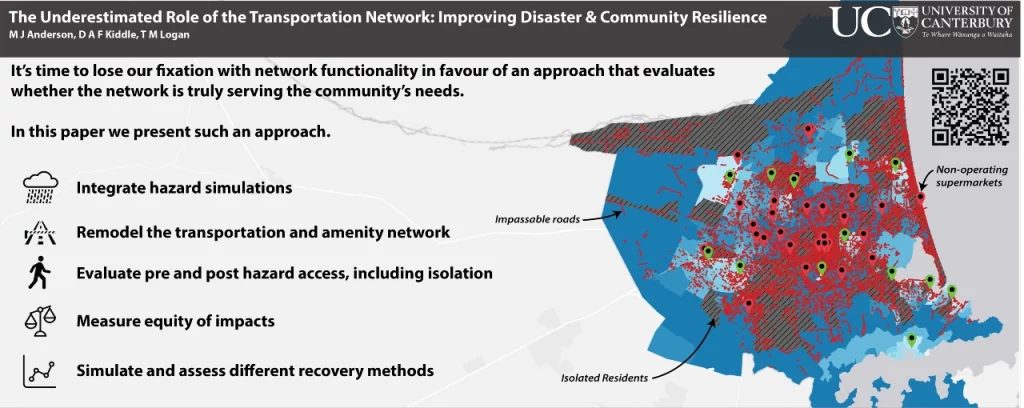
When natural disasters and extreme events cause the closure or damage of transportation networks like roads and bridges, how can governments and planners ensure that communities have access to critical services and amenities crucial for their recovery, wellbeing, and cohesion, especially after disasters?
Transportation networks play a critical role in supporting and improving a community’s resilience by ensuring access to food, health, emergency services, schools, and recreational facilities. Studies have shown that people with better access to resources have higher resilience, while the opposite is true in poor communities.
A paper by M.J. Anderson, D.A.F. Kiddle, and T.M. Logan, “The underestimated role of the transportation network: Improving disaster & community resilience,” published in Transportation Research, investigated the role of the transportation network in providing adequate and equitable access to amenities and services, which is key to community resilience.
Mitchell Anderson, the study’s lead author writes:
While numerous studies have been completed to understand the reliability and resilience of transport networks, current assessments often neglect two things: the wider objective of the network (which is to allow people to travel between destinations of interest) and the variety of needs (and therefore destinations) of the people that the network serves.
Yet, the transport network is all but redundant if there are no operable destinations. Without considering the operational status of destinations, fixation on the network’s functionality can lead to a distorted understanding of the impacts that disruption has on access and community function.
Therefore, to better understand the resilience of a transportation network and its impacts on a community we must reconsider and broaden the approach to measure that resilience.
To address these gaps, our objective was to enhance the understanding of the role of the transportation network in community resilience.
We achieve this by developing and demonstrating an approach to evaluate the direct and indirect impacts of a disruption on a transportation network and the community’s ability to access services.
The approach is based on the ability to modify the transport network for an entire city to reflect potential damage (direct impacts), in a manner that is computationally efficient and therefore practicable to integrate into repeated hazard simulation.
To measure the indirect impacts, we evaluate how a community’s access, and the equity of that access, changes as a result of the transportation network’s disruption and closures to essential services. This enables a better and broader understanding of how and where residents will be affected by potential hazards.
To demonstrate this approach with different types of hazards (earthquake liquefaction, pluvial flooding, and tsunami) we consider three cities: Seattle (WA, USA), Houston (TX, USA), and Christchurch (New Zealand).
These case studies are used to demonstrate:
(1) how access and access equity changes across different demographic groups, incorporating uncertainty;
(2) regions prone to isolation and their demographics composition; and
(3) the potential for multi-criteria optimisation to aid decision-makers in the process of coordinating an equitable restoration program.
See the interactive dashboard demonstrating our results ➝ https://projects.urbanintelligence.co.nz/access-resilience/
Transportation network resilience is one important area in climate adaptation, where communities can be more resilient in times of climate change disaster events.
To read the full study, please visit the link provided in the “Source Citation” below.
Source Citation:
M.J. Anderson, D.A.F. Kiddle, T.M. Logan, The underestimated role of the transportation network: Improving disaster & community resilience, Transportation Research Part D: Transport and Environment, Volume 106, 2022, 103218, ISSN 1361-9209, https://doi.org/10.1016/j.trd.2022.103218.


Leave a Reply